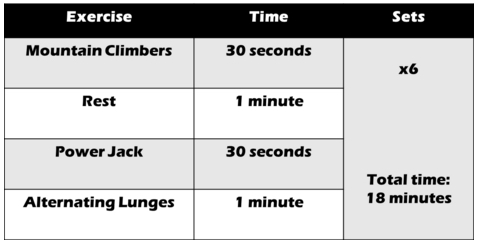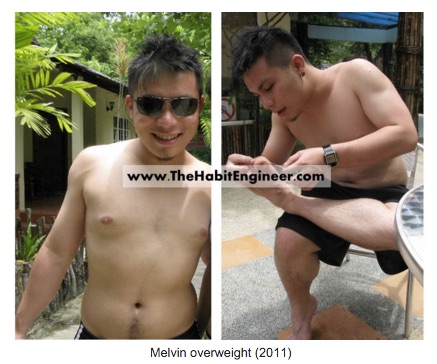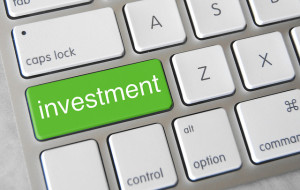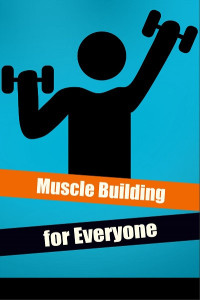A couple of years ago, I shared about how I tried Tim Ferriss’ Slow Carb Diet.
After 13 weeks of eating yong tau foo and avoiding my favourite noodles, I lost 5kg. GREAT SUCCESS!
Actually… not really.
As we all know now, fad diets are unsustainable. Fast forward 2 years, and my fiancee is poking my tummy and making fun of my muffin top:
Okay, I might have gone a little overboard with the Christmas dinners that week
Which is why I now realise that losing weight permanently is not about crash diets or P90X. These may give you some short-term results, but over the long-run, they don’t work.
Come to think of it, losing weight sustainably is a lot like investing.
You could spend every night trading in and out of the market, but statistically speaking, you’ll probably fail to beat the market over the long run. Or you could take the smarter path of low-effort index investing which has way better odds of success in the long-term.
Similarly, you could spend thousands of dollars at a fancy gym, try the latest cold-pressed-Paleo-Atkins diet… and still wake up with a muffin top 2 years later. Or you could work smart from the start and look like a rockstar when you’re 50.
So when Glanies from The Habit Engineer approached me and asked if she could do a guest post on how we could use the principles of investing to lose weight sustainably, I said YES.
I don’t agree to guest posts very often, but this is something that we could all definitely benefit from. Heck, I’m gonna try out her exercise routine myself.
Take it away, Glanies!
—–
“When I was younger, I ate a lot of food and never got fat. Now, eating the same amount of food makes me fat.”
“Why do you want to gain weight now?! Once you cross the 30 year old mark, you’d definitely put on weight. Trust me! There is no escaping! Enjoy eating as much as you can while it lasts!”
These are some lines that have been repeatedly thrown at my male colleague, Craig. Craig is in his late twenties, is rather thin and would like to put on some weight. My older male colleagues constantly chide him for his aspirations and assure him that his desire will come to pass once he enters his 30s.
“This was how thin I was when I was in my 20s *flashes old FB photo*. After I crossed the 30-year old mark, I started putting on weight even though I’m eating less”.
They insist that when they were his age, they were as thin and lean as Craig and that they could eat whatever they wanted, yet not gain weight. However, after they passed the 30-year old mark, they started gaining weight despite minimal changes to their diet. Based on their shared experiences, they’re convinced that Craig will definitely start putting on weight once he enters his 30s.
I find this conversation highly amusing every single time it happens. There is an underlying principle that explains the ‘inescapable’ post-30 weight gain.
In today’s post, you’d learn what that principle is.
Let’s start with what you understand very well – investments.
As investors, we understand inflation as an inescapable phenomenon that erodes our wealth over time. Hence, we invest our money in the stock market so that it will work for us while we are at rest to beat inflation. That way, at the very least, we get to maintain our purchasing power over time without having to do more work for money.
Healthwise, there is also an inescapable phenomenon that erodes our metabolism over time. It is called sarcopenia – age-related muscles loss. Just like how inflation causes our wealth to depreciate steadily over time, sarcopenia causes us to lose muscle mass gradually over time, resulting in reduced metabolism. The older we are, the more muscle we lose. The more muscle we lose, the poorer our metabolism.The poorer our metabolism, the faster we gain weight.
It’s a fact of life, much like inflation.
Inescapable.
Hence, with lesser muscle and a lower metabolic rate, it is little wonder why my older colleagues noticed that they had magically gained weight once they passed 30. Even though they were eating the same amount of food, their metabolic rate had slowed down and their bodies are unable to burn all that they were eating, resulting in excess calories that got stored as fat.
What should we do then?
If you are an investor, you invest because you know clearly the effects of inflation, and you know you have to at the very least, beat inflation. Similarly, if our goal is to lose unwanted weight and keep fit as we age, we have to at the very least, beat sarcopenia.
If we match sarcopenia (i.e. build muscle to match the rate of loss), we maintain our level of fitness.
If we beat sarcopenia (i.e. build muscle to outpace the rate of loss), we lose fat and become leaner and stronger.
The bottom line is, for weight loss, we need to build muscle faster than we lose it due to aging.
Yes, you read it right. There is work to do. We need to build muscle.
You: “What? Does that mean I have spend all my free time exercising?!?!”
Me: No. You don’t have to. You just have to work smart.
Investing in the stock market is a smart strategy because your money grows while you are at rest. There is no need to take a second job just to protect your wealth against inflation. Investing in index funds is another smart long-term strategy for time-starved individuals who do not want to spend time and effort monitoring the stock market.
Just like how there are smart ways to grow your money for busy individuals, there are also smart ways for the busy to lose unwanted weight and to build muscles.
The most efficient way is one that takes 1) the least amount of time yet 2) provides you with the most benefits while at rest.
The two most common exercises people take part in to lose weight are:
- Low-impact cardio activities (e.g. running, swimming, cycling); and
- Resistance training (e.g. exercises involving free weights or body weight or high intensity training).
Based on the two criterions above, which is a smarter strategy for busy people like you and me?
Let’s start with cardio. Doing low-impact cardio in order to lose weight is like working (e.g. earning a salary) in order to build your wealth. When you work, you receive a salary. Once you stop working, you get nothing. Similarly, when you do cardio workouts, your metabolism increases during the activity and your body burns calories, which is your salary for working out. However, once the workout ends, metabolism returns to normal and you do not burn anymore. If you’d like to burn more calories, you’d have to put in more time and prolong your workout.
On the other hand, doing resistance training is like investing (e.g. putting your money in the stock market so it grows while you are at rest). Similar to cardio workouts, you burn calories the session. The important difference is that your body continues to burn calories after the workout because resistance training stimulates the growth of lean muscles.
This phenomenon is known as the afterburn effect. Like how your money grows in the stock market while you are at rest, if you do resistance training, your body continues to burn fat while you are at rest. Furthermore, the more lean muscle you carry around, the higher your resting metabolism. The higher your resting metabolism, the more calories you burn at rest.
With a higher resting metabolism, you can either eat more calories with no impact on your physique or you can lose fat and look freaking hot.
So, if you only have 30 minutes or less to spare to exercise in order to lose weight and to build muscles, the best use of that time will be to do resistance training. In other words, the most important investment for permanent weight loss is to build muscles.
You don’t even have to go to the gym to do resistance training. Here’s an example of a home workout for beginners that allows you to build muscles and blast those tummy fat.
 Find the links to the videos here:
Find the links to the videos here:
This workout is taken from a customised program I created for myself and my husband, Melvin, to suit our crazy, busy lifestyles. I am a busy professional working at a demanding office desk job. Melvin is a touring audio engineer with unpredictable schedules and work days as long as 20 hours. Thus, we needed a fitness plan that was convenient, efficient and short!
Well, with just 20-30 minutes of resistance training, 4-5 times a week, here are our results.




There are many ways to do resistance training. Our preference is to do bodyweight exercises at home because the weather doesn’t matter, and most importantly, we do not have to waste time leaving the house.
If you still prefer to do regular jogging, swimming or cycling, then get the most out of the time you spend by making a small tweak. Instead of going at a steady speed for 30 minutes, incorporate high intensity sprints into your workouts. For jogging, start with sprinting for 30 seconds and jogging for 2 minutes. Do 8 – 12 sets (20 – 30 minutes). Once you feel your body has grown accustomed to this regime, increase the intensity. Do 45 seconds sprints and 3 minutes jogs for a total of 20 – 30 minutes.
Apart from doing resistance training, we also made small tweaks in our diet which complemented our fitness regime. As my gift to you for your pursuit of better health, I’d like to give you my free e-Book: 21 Essential Habits For Permanent Weight Loss. In it, you’d learn the exact habits that Melvin and I used to burn fat and eat better despite living a crazy, busy life.
Specifically, you’d learn
- How to start burning fat today
- Our #1 secret weapon for permanent weight loss
- The exact eating behaviours for permanent weight loss
Get the free e-Book: 21 Essential Habits for Permanent Weight Loss here!
—
 Glanies is the founder of The Habit Engineer. As a busy desk bound professional, she struggled to stay lean and eat well. While working full-time, she made small but clever tweaks to her busy lifestyle to burn fat and attain her dream body. As a certified Precision Nutrition Level 1 coach and a Psychology major, she now helps other busy professionals lose weight, flatten tummies and eat better, a habit at a time.
Glanies is the founder of The Habit Engineer. As a busy desk bound professional, she struggled to stay lean and eat well. While working full-time, she made small but clever tweaks to her busy lifestyle to burn fat and attain her dream body. As a certified Precision Nutrition Level 1 coach and a Psychology major, she now helps other busy professionals lose weight, flatten tummies and eat better, a habit at a time.
Image credits: jakerust, shuttercat7, themacinator





[…] By Lionel Yeo […]